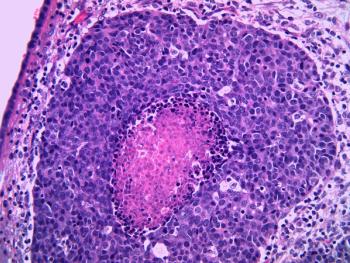
Targeting G Protein–Coupled Receptors With CAR T-Cell Therapy Shows Promise Treating Multiple Myeloma
Researchers identified a new immunotherapeutic target that may be effectively treated with CAR T-cell therapy in patients with pretreated multiple myeloma.
Chimeric antigen receptor (CAR) T cells that target the G protein–coupled receptor, class C, group 5, member D (GPRC5D), may be an effective immunotherapeutic treatment for patients with multiple myeloma, according to a new phase 1 dose-escalation study published in the New England Journal of Medicine.
Among participants, 71% responded to GPRC5D-targeted CAR T-cell therapy (MCARH109).
“The results of this study of a GPRC5D-targeted CAR T-cell therapy (MCARH109) confirm that GPRC5D is an active immunotherapeutic target in multiple myeloma,” the study authors wrote in the report.
CAR T-cell therapy could be an effective treatment for numerous hematologic cancers. B-cell maturation antigen (BCMA) CAR T-cell therapy has shown efficacy across multiple advanced cancer states. However, BCMA-directed CAR T-cell therapies still result in relapse among patients, after which treatment options become incredibly limited.
An orphan G protein-coupled receptor, GPRC5D, is heavily expressed in multiple myeloma cell lines and bone marrow plasma cells, which prompted researchers to study the efficacy of CAR T-cell therapy to treat current or recurrent cases of multiple myeloma.
The primary endpoint was safety of MCARH109, with key secondary endpoints of clinical response according to the International Myeloma Working Group response assessment criteria and low residual disease found in the bone marrow.
The phase 1 dose-escalation study enrolled 17 patients with heavily pretreated multiple myeloma, some of whom were relapsed patients with previous BCMA CAR T-cell therapy. In the trial, patients with relapsed or refractory multiple myeloma (and those with prior BCMA-directed therapies) were given MCARH109 at 4 dose levels—25 x 106, 50 x 106, 150 x 106, and 450 x 106 CAR T cells.
The researchers discovered that multiple myeloma actively targeted GPRC5D, even when it was administered at a low dose. The maximum tolerated dose was 150×106 CAR T cells.
“A high likelihood of response was noted across all dose levels and particularly among patients with limited or no other therapeutic options such as those with relapses or disease refractory to previous BCMA-therapies, including anti-BCMA CAR T-cell therapies,” the study authors wrote.
Among these patients, 71% experienced clinical response at the evaluated dose, and almost half of those previously treated with BCMA CAR T-cell therapy experienced a positive response.
Further, 71% also experienced grade 1 or 2 toxic adverse effects, which included symptoms of transient rash, dysgeusia, and nail changes. However, toxicity appeared to be severe at the higher dose 450 x 106 CAR T cells. Of the patients administered this dose, 60% experienced persistent cerebellar disorder. Researchers will begin to look deeper in the role of GPRC5D and targeting it to treat myeloma.
“GPRC5D as an additional new target in myeloma offers the opportunity to explore several unanswered questions, including the role of targeting alternate antigens as opposed to sequential BCMA-directed therapies in patients with relapse after BCMA therapy and the role of BCMA- and GPRC5D-directed combination therapies to target low-antigen-density reservoirs of relapse and induce deeper and longer durations of response,” the study authors concluded in the report.
Reference
Mailankody, Sham, Devlin, Sean, Landa, Jonathan, et al. GPRC5D-Targeted CAR T Cells for Myeloma. October 5, 2022. N Engl J Med 2022;387:1196-206. DOI: 10.1056/NEJMoa2209900
Newsletter
Stay informed on drug updates, treatment guidelines, and pharmacy practice trends—subscribe to Pharmacy Times for weekly clinical insights.

















































































































































































































